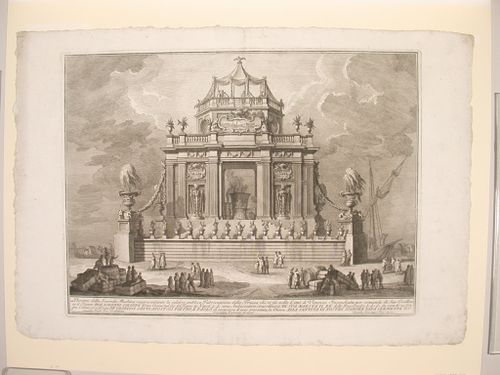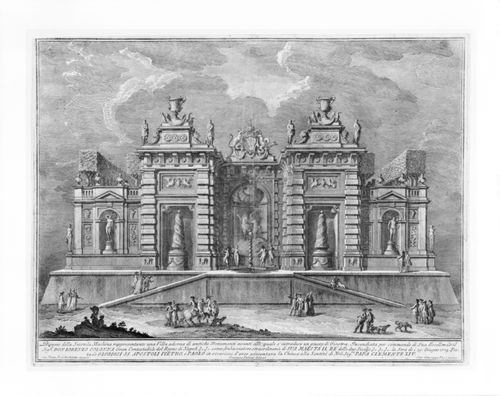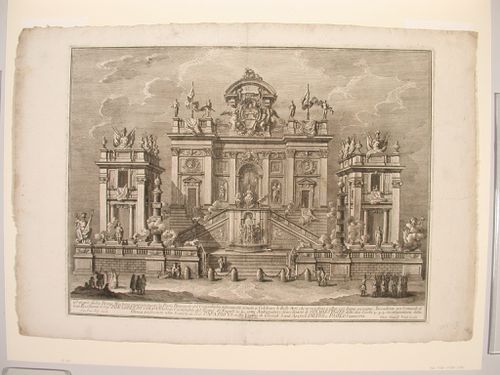DR1988:0437:046
Description:
- This etching for a fireworks construction or macchina is in the form of a temple dedicated to peace. The temple appears to be centrally-planned, consisting of a square lower story crowned by a shallow dome similar to that of the Pantheon except that is roofed with fish-scale shingles. The front façade is in the form of a triumphal arch.
temporary architecture
printed 1773
Etching of Posi's design for the "prima macchina" of 1773
Actions:
DR1988:0437:046
Description:
- This etching for a fireworks construction or macchina is in the form of a temple dedicated to peace. The temple appears to be centrally-planned, consisting of a square lower story crowned by a shallow dome similar to that of the Pantheon except that is roofed with fish-scale shingles. The front façade is in the form of a triumphal arch.
temporary architecture
DR1988:0437:047
Description:
- This etching of a fireworks construction or macchina represents a public celebration of the making of a poison antidote "che si fà nella Città di Venezia" (as it is done in Venice). The macchina consists of a pavilion raised on a base. The pavilion appears to be square, with a central opening a large smoking vat of theriaca. The top storey appears to be octagonal and is crowned by a tent. The relief on the front of the octagon shows a view of the Piazza San Marco and the Doge's Palace from the Molo.
temporary architecture
printed 1773
Etching of Posi's design for the "seconda macchina" of 1773
Actions:
DR1988:0437:047
Description:
- This etching of a fireworks construction or macchina represents a public celebration of the making of a poison antidote "che si fà nella Città di Venezia" (as it is done in Venice). The macchina consists of a pavilion raised on a base. The pavilion appears to be square, with a central opening a large smoking vat of theriaca. The top storey appears to be octagonal and is crowned by a tent. The relief on the front of the octagon shows a view of the Piazza San Marco and the Doge's Palace from the Molo.
temporary architecture
DR1988:0437:048
Description:
- This etching for a fireworks construction or macchina represents Hercules in the Gardens of the Hesperides. The macchina is in the form of a three-bay garden pavilion with sculptures and fountains.
temporary architecture
printed 1774
Etching of Posi's design for the "prima macchina" of 1774
Actions:
DR1988:0437:048
Description:
- This etching for a fireworks construction or macchina represents Hercules in the Gardens of the Hesperides. The macchina is in the form of a three-bay garden pavilion with sculptures and fountains.
temporary architecture
DR1988:0437:049
Description:
- This etching for a fireworks construction or macchina represents a villa decorated with antique statues,including busts, hermes, and full figure works.
temporary architecture
printed 1774
Etching of Posi's design for the "seconda macchina" of 1774
Actions:
DR1988:0437:049
Description:
- This etching for a fireworks construction or macchina represents a villa decorated with antique statues,including busts, hermes, and full figure works.
temporary architecture
DR1988:0437:050
Description:
- This etching for a fireworks construction or macchina represents the Campidoglio (Capitol) decorated with drapery and trophies for a festival.
temporary architecture
printed 1775
Etching of Posi's design for the "prima macchina" of 1775
Actions:
DR1988:0437:050
Description:
- This etching for a fireworks construction or macchina represents the Campidoglio (Capitol) decorated with drapery and trophies for a festival.
temporary architecture
Project
AP178.S1.2002.PR05
Description:
This project series documents the Parque de Vidago in Vidago, Portugal. While the records were held in the office’s archives this project was assigned the number 49/00. The office assigned the dates 2002-2010 to this project. This project consisted of extensive modifications to the spa resort Parque de Vidago Palace Hotel for owner VMPS - Águas & Turismo, S.A, part of Unicer (now Super Bock Group). The Palace Hotel and its surrounding nature park were originally proposed by King Carlos I at the beginning of the 20th century in order to create a luxurious resort around the famous Vidago mineral springs. In 2006, the resort was temporarily closed for the work to begin. For Siza, this primarily consisted of the construction of a new thermal spa, the conversion of rural buildings into vacation homes, and the building of a new clubhouse for the golf course. These three aspects of the project were divided as three subprojects by the office and have been arranged under AP178.S1.2002.PR05.SS1, AP178.S1.2002.PR05.SS2 and AP178.S1.2002.PR05.SS3, respectively. While the spa and clubhouse were both built, the vacation homes were not realized. The resort reopened in 2010. Several smaller buildings were also realized as part of this project including the Fonte Salus (spring), the Fonte de Vidago (spring) and the Portaria (gatehouse). Materials for these three building are arranged in AP178.S1.2002.PR05.SS1. Also included were several buildings that were not realized such as the Academia de golfe and the Edifício da manutenção (arranged in AP178.S1.2002.PR05.SS3), and the Espaço Serralves (arranged in AP178.S1.2002.PR05.SS1). This project was realized in tandem with another similar project by Siza, the Parque de Pedras Salgadas (AP178.S1.2002.PR06), also owned by Unicer. For this reason, the materials for both projects are mixed together. Files in this project series that contain materials for the Pedras Salgadas project have been identified at the file level.
2002-2012
Parque de Vidago [Vidago Palace], Vidago, Portugal (2002-2010)
Actions:
AP178.S1.2002.PR05
Description:
This project series documents the Parque de Vidago in Vidago, Portugal. While the records were held in the office’s archives this project was assigned the number 49/00. The office assigned the dates 2002-2010 to this project. This project consisted of extensive modifications to the spa resort Parque de Vidago Palace Hotel for owner VMPS - Águas & Turismo, S.A, part of Unicer (now Super Bock Group). The Palace Hotel and its surrounding nature park were originally proposed by King Carlos I at the beginning of the 20th century in order to create a luxurious resort around the famous Vidago mineral springs. In 2006, the resort was temporarily closed for the work to begin. For Siza, this primarily consisted of the construction of a new thermal spa, the conversion of rural buildings into vacation homes, and the building of a new clubhouse for the golf course. These three aspects of the project were divided as three subprojects by the office and have been arranged under AP178.S1.2002.PR05.SS1, AP178.S1.2002.PR05.SS2 and AP178.S1.2002.PR05.SS3, respectively. While the spa and clubhouse were both built, the vacation homes were not realized. The resort reopened in 2010. Several smaller buildings were also realized as part of this project including the Fonte Salus (spring), the Fonte de Vidago (spring) and the Portaria (gatehouse). Materials for these three building are arranged in AP178.S1.2002.PR05.SS1. Also included were several buildings that were not realized such as the Academia de golfe and the Edifício da manutenção (arranged in AP178.S1.2002.PR05.SS3), and the Espaço Serralves (arranged in AP178.S1.2002.PR05.SS1). This project was realized in tandem with another similar project by Siza, the Parque de Pedras Salgadas (AP178.S1.2002.PR06), also owned by Unicer. For this reason, the materials for both projects are mixed together. Files in this project series that contain materials for the Pedras Salgadas project have been identified at the file level.
Project
2002-2012
photographs
PH1987:1084:147:001-006
architecture
1858
Panorama of Lucknow taken from the roof of a building in the Kaisarbagh (also known as the Qaisarbagh), India
Actions:
PH1987:1084:147:001-006
photographs
1858
architecture
photographs
PH1987:1084:147:004
architecture
1858
photographs
1858
architecture
PH1982:0705
architecture
between 1895 and 1940
architecture
DR1988:0437:016
temporary architecture
printed 1749
temporary architecture





![View of the Denkmal für die Befreiungskriege [Memorial for the Wars of Liberation], Kreuzberg, Berlin, Germany](/img-collection/0OooVJqpPd8vBntNtFt6_Zqa_W0=/500x666/13902.jpg)
